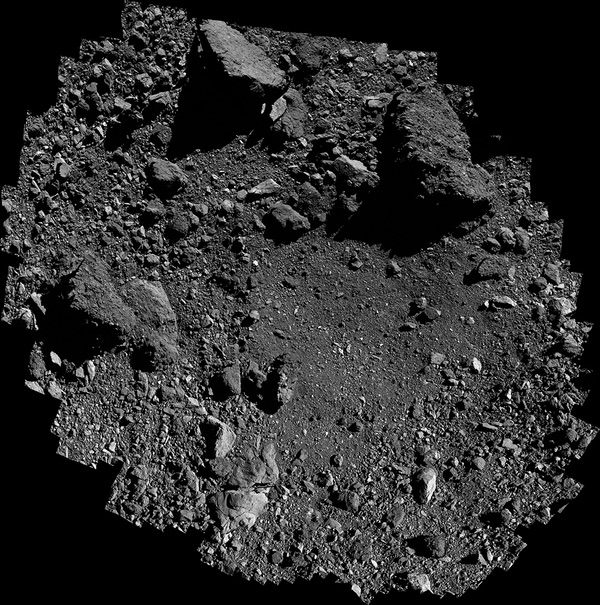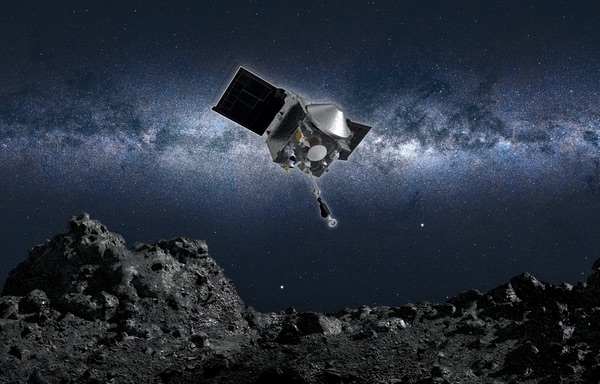TAG, Bennu, you’re itby Jeff Foust
|
| “Bennu has not made things easy for us,” said Moreau. |
Those samples will be returned to Earth in September 2023 for analysis by scientists, the payoff for the billion-dollar mission launched four years ago. “Asteroids are relics of the earliest material that formed the planets in our solar system, and they hold key information to unlocking our understanding of how the solar system formed and how it evolved,” said Lori Glaze, director of NASA’s planetary science division, during a briefing last month about the sampling effort.
While some missions do such science by sending instruments to asteroids, OSIRIS-REx will, in effect, send the asteroid to much better instruments in terrestrial labs, as Japan’s Hayabusa spacecraft did a decade ago (Hayabusa2 will return samples from a second asteroid in December.)
“Sample return is an important strategy for NASA and for planetary science,” she said. “On Earth, we can apply the full breadth of our terrestrial science laboratory capabilities to study the physical and the chemical characteristics of these pristine, unaltered materials in our state-of-the-art laboratories.”
The concept sounds simple, but the execution is as complex as the mission’s name. “Bennu has not made things easy for us,” said Mike Moreau, OSIRIS-REx deputy project manager.
The asteroid, it turns out, is far less hospitable place for a sampling effort than the mission designers originally thought. “We did a lot of work characterizing Bennu telescopically prior to launch,” said Dante Lauretta, principal investigator for OSIRIS-REx at the University of Arizona. Both infrared observations and radar images of the asteroid made before launch suggested the asteroid was “beach-like,” with particles the size of sand grains dominating the surface. That would make it relatively easy for the spacecraft to touch down and collect samples.
Once OSIRIS-Rex arrived at the asteroid two years ago, he said, “I knew right away we were in for a challenge.” The surface was, in fact, littered with much larger boulders. The plan was to find an area at least 50 meters across with fine-grained material for the sampling attempt. “There is nothing that big on the surface of the asteroid that looks like is sampleable with our TAGSAM device.”
The mission then worked to find both smaller regions that could be suitable, as well as refine the approach technique. Scientists found four potential landing sites, which they then studied in greater detail with close approaches of them, collecting images with resolutions as sharp as 3.5 millimeters per pixel. “We counted all of those rocks,” he said. “We have a team of students here at the University of Arizona that are expert asteroid rock counters.” That effort led to the selection of Nightingale as the preferred landing site.
 A mosaic of images taken by OSIRIS-REx during close approaches to Nightingale, the primary sampling site. (credit: NASA/Goddard/University of Arizona) |
Engineers, in the meantime, were working to improve the accuracy of the spacecraft’s approach to the asteroid to make a sampling attempt in Nightingale feasible. One, said Moreau, is “natural feature tracking,” where the spacecraft’s computers process images taken during descent in order to refine the approach autonomously, since the spacecraft is too far away from Earth to allow teleoperation. It will also compare the projected touchdown site with a “hazard map” of unsafe locations within Nightingale, allowing it to abort the approach if those hazards can’t be avoided. Among those hazards: a boulder the size of a two-story building on the edge of the Nightingale site dubbed “Mount Doom.”
The second was to improve the understanding of the spacecraft itself, refining models of the small forces on the spacecraft and calibrating the performance of the thrusters. Moreau said they can now control the spacecraft’s velocity with a precision of just 0.1 millimeters per second. Those changes now allow the spacecraft to target an area just eight meters across, versus 50 meters as originally planned. Without those changes, he said, “it would be impossible to tag at Nightingale.”
If that approach goes as planned the TAGSAM sampling head will touch down on a sandy part of Bennu. “It looks a lot like an air filter you might find in an older vehicle,” said Sandra Freund, OSIRIS-REx mission operations manager at Lockheed Martin, which built the spacecraft. It acts like a “reverse vacuum cleaner,” she said, firing nitrogen gas that lifts up fine-grained material on the surface that is then captured inside the sampler head. The spacecraft pulls away from the asteroid five to ten seconds after touchdown.
| Among the hazards the spacecraft must avoid: a boulder the size of a two-story building on the edge of the Nightingale site dubbed “Mount Doom.” |
It will take several days to know how much material the spacecraft collected. Lauretta said they will measure the mass of the sample by spinning the spacecraft slowly after the capture attempt, comparing the change in its moment of inertia from before the attempt. That will allow them to estimate how much material it collected to a precision of several tens of grams.
The goal of the mission is to collect at least 60 grams of material. “If we get a sample mass measurement value of about 79 grams or larger, we estimate that’s a 90% confidence of 60 grams or more in the TAGSAM head,” he said. “Anything below that, then we’re having a conversation” with the leadership of NASA’s science directorate about next steps.
“Suppose there’s the case where we’re just a little bit under the 60 [grams],” said Thomas Zurbuchen, NASA associate administrator for science. “The discussion that we’re going to have is very much focused on what’s the right thing to maximize mission success.”
If OSIRIS-REx collects less than 60 grams, or if the sample collection maneuver is aborted for some reason, there’s an opportunity for second attempt, likely in January. Moreau said they need a couple weeks to assess the state of the spacecraft after the first TAG attempt, then perform a series of burns to line the spacecraft up for a second attempt, which will take will take a few more weeks. There’s also giving the spacecraft team “a little bit of a breather between these very intense events.”
Mission leaders, though, are optimistic that they will get at least 60 grams, and perhaps much more, on that first attempt. Moreau estimated there was a 6% chance that the approach would be waved off because of a warning from the hazard map. There’s a bigger chance that the TAGSAM will touch down on an area without the fine-grained material it can ingest. There’s a 30% chance of that happening, he said.
Still, “by far the most likely outcome that we will have on October 20th is that we will contact the surface and come away with a large sample that exceeds our minimum requirements,” he said. “But Bennu has thrown us a number of curveballs already.”
Note: we are temporarily moderating all comments submitted to deal with a surge in spam.
